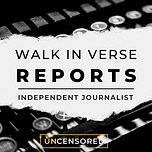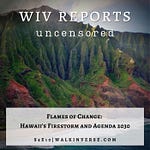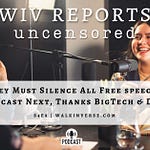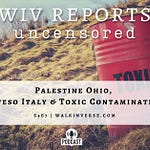Recorded May 27, 2020
https://walkinverse.buzzsprout.com/
In episode #12, "HR 6666, the Overview," I show the dangers in this bill and share some insight. This is a multi-part podcast that will dive into 4th Amendment violations and privacy issues surrounding contact tracing.
Overview
H.R. 66661
This bill authorizes the Centers for Disease Control and Prevention (CDC) to award grants for testing, contact tracing, monitoring, and other activities to address COVID-19 (i.e., coronavirus disease 2019). Entities such as federally qualified health centers, nonprofit organizations…
By the ambiguous words used in this bill we are at risk. When they say nonprofit organizations, we the people need to know who they are. One of the organizations used for tracing is Partners in Health 2, which I will dive into later.
As we continue to read the overview is states
… awarding the grants, the CDC shall prioritize applicants that (1) operate in hot spots and medically underserved communities, and (2) agree to hire individuals from the communities where grant activities occur.
Another concern is how they will hire. We have seen with Census workers they have hired felons and child sex offenders for workers under their programs. And in 2020 3 they did it again to help with the Census count. I cannot even imagine who they will find for H.R. 6666.
SEC. 2. COVID–19 TESTING AND CONTACT TRACING USING MOBILE HEALTH UNITS.
This section, “COVID-19 Testing, Reaching, And Contacting Everyone (TRACE) Act 1”, it’s interesting as it sets the basis for fourth amendment and additional privacy rights violations. It will allow for entry into a home, to potentially quarantine and collect identifiable data by workers who may not be so qualified especially due to the individuals they hire from the communities of underserved and hot spot areas.
2 (a) General
In this section 2a – General;
The Secretary of Health and Human Services, acting through the Director of the Centers for Disease Control and Prevention, may award grants to eligible entities to conduct diagnostic testing for COVID–19, to trace and monitor the contacts of infected individuals, and to support the quarantine of such contacts, through—
And the vehicles in which they will pursue is via mobile health units and residential quarantine & testing.
Again, it’s loosely defined leaving for interpretation.
2 (b) Funding
A grant recipient under this section may use the grant funds, in support of the activities described in subsection
(1) to hire, train, compensate, and pay the expenses of individuals; and
(2) to purchase personal protective equipment and other supplies.
This section I found interesting. To hire someone is to pay and with it comes training. And with training comes compensation. But for what?
Many online schools are offering free training4 with certificates. But, the issue with these courses is the misinformation throughout. And what is even more bothersome is John Hopkins, the same University behind Event 201 5, funded by the Bill and Melinda Gates foundation is offering these classes.
Some of the topics include the history of SARS-CoV-2, interventions through contact tracing, identify common barriers and how to overcome and my favorite, ethical consideration around tracing, isolation and quarantine.
Next is they will compensate and pay expenses which is starting to sound a lot like contractors or mercenaries.
compensate
Compensate is a verb and it means;
1 [with object] give (someone) something, typically money, in recognition of loss, suffering, or injury incurred;
Why I bring this to the forefront is in the bill it mentions to pay, and the word compensate. You would not pay and compensate if you did not expect some kind of loss.
pay expenses
Next is to pay expenses. And again, it has the feeling of a contractors who must reimburse themselves and well as a mercenary who is hired to pay without thought of consequences in whom they engage.
2 (c) Priority
They will hire anyone from hot spot communities, or any individual areas that lack access to primary care.
In selecting grant recipients under this section, the Secretary shall give priority to—
(1) applicants proposing to conduct activities funded under this section in hot spots and medically underserved communities; and
Medically Underserved Areas6
An example of who they will target is the Homeless. In Austin Texas they are testing ID20207 to track medical and criminal records of these individuals using blockchain technology to digital identity and 5G to scale. Other types of individuals on are those who are Medicaid-eligible, Native American and Migrant farmworkers.
There is always an exception to the rule. If they wish to go after other areas, the requesting person must explain the reason along with written consent to the person in charge. Such as a state’s governor or representative and the local health official. Again, vague usage of who they must submit the request to as it leaves them room for working with third parties.
2 (e) Federal privacy requirements
This section quotes a few interesting laws in which they must adhere to while performing their tracing tasks.
Nothing in this section shall be construed to supersede any Federal privacy or confidentiality requirement, including the regulations promulgated under section 264(c)8 of the Health Insurance Portability and Accountability (HIPPA) Act of 1996 (Public Law 104–191; 110 Stat. 2033) and section 543 of the Public Health Service Act (42 U.S.C. 290dd–2).
Section 264(c) Regulations
These regulations center on a person's identifiable health data connected with electronic data exchange, as stated in section1173(a) 9 of the Social Security Act, as referenced in section 262 from the HIIPA Act of 1996 dealing with data administration. Also, a time limit, not exceed 42 months (4 years), is stated for compliance.
An interesting point is a presidential term is four years. To pull off digital identity at scale, a president would need to fast track the implementation. It means 5G nationwide coupled with blockchain to create an immutable system of record for wide-scale digital identities.
In an earlier podcast10, I discussed how the FCC approved SpaceX11 on March 29, 2018, to launch 4,425 5G satellites into low orbit around the Earth. The total number of satellites expected will range from 20K up to 42K by 202712, making digital id a reality.
section 54313 of the Public Health Service Act (42 U.S.C. 290dd–2)
section (a) Requirement
Records of the identity, diagnosis, prognosis, or treatment of any patient which are maintained in connection with the performance of any program or activity relating to substance use disorder education (sickness, illness), prevention, training, treatment, rehabilitation, or research, which is conducted, regulated, or directly or indirectly assisted by any department or agency of the United States shall, except as provided in subsection (e), be confidential and be disclosed only for the purposes and under the circumstances expressly authorized under subsection (b).
section (b) Permitted disclosure
(1) Consent
The following shall apply with respect to the contents of any record referred to in subsection (a):
(A) Such contents may be used or disclosed in accordance with the prior written consent of the patient with respect to whom such record is maintained.
Subsection (B, C) states that once you have given your consent, then anyone defined in this section can use your data now and in the future. This will include treatments, payments, health care operations, until the patient revokes consent in writing. But the bill does not define where you send your letter to.
(2) Method for Disclosure
In section (2) titled Method for Disclosure, defines how the data can be used when consent is not given.
Section 2a allows medical personnel only to use the data to meet the need of the medical emergency. Then in section 2b in addresses what qualified personnel can do. These individuals are only allowed to use non-identifiable information for scientific research, financial and management audits, and evaluation of the program. They are not allowed to use any of this data to identify a person directly or indirectly. Section 2c continues to address the court's power for access in extreme cases for a good cause in the public interest. This is where the Katz test14 comes into play as well as other privacy tests established by the supreme court case law.
I will cover this in more detail when I discuss the fourth amendment.
Section 2d focuses on the role of a public health authority as defined under section 164.514(b) of title 45, Code of Federal Regulations15 for creating de-identified information.
section 164.514(b) of title 45, Code of Federal Regulations15
45 CFR § 164.514 - Other requirements relating to uses and disclosures of protected health information.
(a) Standard: De-identification of protected health information
Mean that the data cannot be used in any way to identify the individual’s health information.
(b) Implementation specifications: Requirements for de-identification
This section is pretty in depth, but in a nutshell the only information they are allowed to use is the year of birth, admission, discharge or date of death. No month or day allowed. Nothing other information can be used that is considered identifiable in this section. The list of comprehensive on what they cannot collect.
(c) Implementation specifications: Re-identification
Now to re-identify, a covered entity will use a generated code. They cannot create the code from data that can identify the individual. In addition, they are not allowed to share how they created the code nor disclose it to anyone. This is now starting to sound like digital identity plus myPass via blockchain, backed and funded by Bill Gates ID20207 initiative.
section (c) Use of records in criminal, civil, or administrative contexts
Except as otherwise authorized by a court order under subsection (b)(2)(C) or by the consent of the patient, a record referred to in subsection (a), or testimony relaying the information contained therein, may not be disclosed or used in any civil, criminal, administrative, or legislative proceedings conducted by any Federal, State, or local authority, against a patient, including with respect to the following activities:
(1) Such record or testimony shall not be entered into evidence in any criminal prosecution or civil action before a Federal or State court.
(2) Such record or testimony shall not form part of the record for decision or otherwise be taken into account in any proceeding before a Federal, State, or local agency.
(3) Such record or testimony shall not be used by any Federal, State, or local agency for a law enforcement purpose or to conduct any law enforcement investigation.
(4) Such record or testimony shall not be used in any application for a warrant.
References
1. Bobby L. Rush. H.R.6666. (2020).
2. Massachusetts Contact Tracing Program Handed to Clinton-Linked NGO with Questionable Past. MintPress News https://www.mintpressnews.com/massachusetts-contact-tracing-partners-in-health-clinton/267534/ (2020).
3. WATCH, J. Census Bureau Still Hiring Felons, Child Sex Offenders Pass Background Check. Judicial Watch https://www.judicialwatch.org/corruption-chronicles/census-bureau-still-hiring-felons-child-sex-offenders-pass-background-check/ (2019).
4. COVID-19 Contact Tracing. Coursera https://www.coursera.org/learn/covid-19-contact-tracing?edocomorp=covid-19-contact-tracing.
5. Event 201. Center for Health Security https://www.centerforhealthsecurity.org/event201/ (2019).
6. Medically Underserved Areas and Populations (MUA/Ps). Bureau of Health Workforce https://bhw.hrsa.gov/shortage-designation/muap (2016).
7. ID2020. Welcome the City of Austin to the ID2020 Alliance! Medium https://medium.com/id2020/welcome-the-city-of-austin-to-the-id2020-alliance-76b0ebe6776 (2019).
8. STATUTE-110-Pg1936.pdf.
9. SSA, O. Standards for information transactions and data elements. https://www.ssa.gov/OP_Home/ssact/title11/1173.htm#ft246.
10. 5G: A Blessing or a Curse. https://www.buzzsprout.com/906265/3254200-5g-a-blessing-or-a-curse.
11. THOMAS, J. P. 5G From Space: 20,000 Satellites To Blanket The Earth. Technocracy News https://www.technocracy.news/5g-from-space-20000-satellites-to-blanket-the-earth/ (2019).
12. McFall-Johnsen, M. SpaceX’s license to launch hundreds of internet satellites may have violated the law, experts say. Astronomers could sue the FCC. Business Insider https://www.businessinsider.com/spacex-starlink-satellite-license-fcc-environmental-law-2020-1 (2020).
13. [USC02] 42 USC 290dd-2: Confidentiality of records. vol. 42 (2020).
14. Katz v. United States, 389 U.S. 347 | Casetext Search + Citator. https://casetext.com/case/katz-v-united-states-2.
15. 45 CFR § 164.514 - Other requirements relating to uses and disclosures of protected health information. 164.514.














